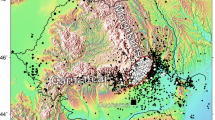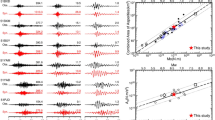Abstract
The 2003 Bam, Iran, earthquake caused catastrophic damage to the city of Bam and neighboring villages. Given its magnitude (M w ) of 6.5, the damage was remarkably large. Large-amplitude ground motions were recorded at the Bam accelerograph station in the center of Bam city by the Building and Housing Research Center (BHRC) of Iran. We simulated the Bam earthquake acceleration records at three BHRC strong-motion stations—Bam, Abaraq, and Mohammad-Abad—by the empirical Green’s function method. Three aftershocks were used as empirical Green’s functions. The frequency range of the empirical Green’s function simulations was 0.5–10 Hz. The size of the strong motion generation area of the mainshock was estimated to be 11 km in length by 7 km in width. To estimate the parameters of the strong motion generation area, we used 1D and 2D velocity structures across the fault and a combined source model. The empirical Green’s function method using a combination of aftershocks produced a source model that reproduced ground motions with the best fit to the observed waveforms. This may be attributed to the existence of two distinct rupture mechanisms in the strong motion generation area. We found that the rupture starting point for which the simulated waveforms best fit the observed ones was near the center of the strong motion generation area, which reproduced near-source ground motions in a broadband frequency range. The estimated strong motion generation area could explain the observed damaging ground motion at the Bam station. This suggests that estimating the source characteristics of the Bam earthquake is very important in understanding the causes of the earthquake damage.












Similar content being viewed by others
References
Aki K (1967) The scaling law of seismic spectrum. J Geophys Res 72:1217–1231
Aki K (1968) Seismic displacement near a fault. J Geophys Res 64:321–342
Berberian M (1976) Quaternary faults in Iran. In: Berberian M (ed) Contribution to the seismotectonics of Iran (Part II). Geological Survey of Iran, Report No. 39, pp 187–258
Bouchon M, Hatzfeld D, Jackson JA, Haghshenas E (2006) Some insight on why Bam (Iran) was destroyed by an earthquake of relatively moderate size. Geophys Res Lett 33:L09309. doi:10.1029/2006GL025906
Brune JN (1970) Tectonic stress and the seismic shear waves from earthquakes. J Geophys Res 75:4997–5009
Brune JN (1971) Correction. J Geophys Res 76:5002
Der ZA, Shumway RH, Hirano MR (1991) Time domain waveform inversion—A frequency domain view: How well we need to match waveforms? Bull Seismol Soc Am 81:2351–2370
Fialko Y, Sandwell D, Simons M, Rosen P (2005) Three-dimensional deformation caused by the Bam, Iran, earthquake and the origin of shallow slip deficit. Nature 435:295–299
Fielding EJ, Talebian M, Rosen PA, Nazari H, Jackson JA, Ghorashi M, Walker R (2005) Surface ruptures and building damage of the 2003 Bam, Iran, earthquake mapped by satellite synthetic aperture radar interferometric correlation. J Geophys Res 110:B03302. doi:10.1029/2004JB003299
Fielding EJ, Lundgren PR, Bürgmann R, Funning GJ (2009) Shallow fault-zone dilatancy recovery after the 2003 Bam, Iran earthquake. Nature 458:64–68
Fukuyama E, Irikura K (1986) Rupture process of the 1983 Japan Sea (Akita-Oki) earthquake using a waveform inversion method. Bull Seism Soc Am 76:1623–1640
Funning GJ, Parsons B, Wright TJ, Jackson JA, Fielding EJ (2005) Surface displacements and source parameters of the 2003 Bam (Iran) earthquake from Envisat advanced synthetic aperture radar imagery. J Geophys Res 110:B09406. doi:10.1029/2004JB003338
Ghayamghamian MR, Hisada Y (2007) Near fault strong motion complexity of the 2003 Bam earthquake (Iran) and low frequency ground motion simulation. Geophys J Int 170:679–686
Graves RW, Wald DJ (2001) Resolution analysis of finite fault source inversion using one- and three-dimensional Green’s functions 1. Strong motions. J Geophys Res 106:8745–8766. doi:10.1029/2000JB900436
Hisada Y (2000) A theoretical omega-squared model considering the spatial variation in slip and rupture velocity. Bull Seismol Soc Am 90:387–400
Hisada Y (2001) A theoretical omega-square model considering spatial variation in slip and rupture velocity, Part 2: Case for a two-dimensional source model. Bull Seismol Soc Am 91:651–666
Hisada Y, Shibaya A, Ghayamghamian MR (2004) Building damage and seismic intensity in Bam city from the 2003 Bam, Iran, Earthquake. Bull Earthquake Res Inst Univ Tokyo 79:81–93
International Seismological Centre (2012) On-line Bulletin, http://www.isc.ac.uk. Int Seismol Cent, Thatcham, UK
Irikura K (1986) Prediction of strong acceleration motion using empirical Green’s function. Proc of the 7th Japan Earthq Eng Symposium, December 8, Tokyo, pp151–156
Irikura K, Kamae K (1994) Estimation of strong ground motion in broad frequency band based on a seismic source scaling model and an empirical Green’s function technique. Ann Geofis 37:1721–1743
Jackson J, Bouchon M, Fielding E, Funning G, Ghorashi M, Hatzfeld D, Nazari H, Parsons B, Priestley K, Talebian M, Tatar M, Walker R, Wright T (2006) Seismotectonic, rupture process, and earthquake hazard aspects of the 2003 December 26 Bam, Iran, earthquake. Geophys J Int 166:1270–1292
Kamae K, Irikura K (1998) Source model of the 1995 Hyogo-ken Nanbu earthquake and simulation of near source ground motion. Bull Seismol Soc Am 88:400–412
Kostrov BV (1964) Self-similar problems of propagation of shear cracks. J Appl Math Mech 28:1077–1087
Liu HL, Helmberger DV (1985) The 23:19 aftershock of the 15 October 1979 Imperial Valley earthquake: more evidence for an asperity. Bull Seismol Soc Am 75:689–708
Miyake H, Iwata T, Irikura K (2003) Source characterization for broadband ground-motion simulation: Kinematic heterogeneous source model and strong motion generation area. Bull Seismol Soc Am 93:2531–2545
Miyake H, Koketsu K, Mostafaei H (2004) Rupture process of the 2003 Bam, Iran, earthquake: Did shallow asperities on a fresh fault cause extreme ground motions? EOS Trans AGU (Fall Meet Suppl) 85:T23A–T0575A
Mostafaei H, Kabeyasawa T (2004) Investigation and analysis of damage to buildings during the 2003 Bam Earthquake. Bull Earthquake Res Inst Univ Tokyo 79:107–132
Motagh M, Klotz J, Tavakoli F, Djamour Y, Arabi S, Wetzel H, Zschau J (2006) Combination of precise leveling and InSAR data to constrain source parameters of the Mw = 6.5, 26 December 2003 Bam earthquake. Pure Appl Geophys 163:1–18
Nakamura T, Suzuki S, Sadeghi H, Fatemi Aghda SM, Matsushima T, Ito Y, Hosseini SK, Gandomi AJ, Maleki M (2005) Source fault structure of the 2003 Bam earthquake, southern Iran, inferred from the aftershock distribution and its relation to the heavily damaged area: Existence of the Arg-e-Bam fault propose. Geophys Res Lett 32:L09308. doi:10.1029/2005GL022631
NCCI (2004) Damage distribution to dwellings, Bam. National Cartographic Center of Iran, http://www.ncc.org.ir/_DouranPortal/images/unexpected/BAMfinal_H.jpg, Accessed 08 December 2011
Peyret M, Chéry J, Djamour Y, Avallone A, Sarti F, Briole P, Sarpoulaki M (2007) The source motion of 2003 Bam (Iran) earthquake constrained by satellite and ground-based geodetic data. Geophys J Int 169:849–865
Poiata N (2010) The origin of near-fault ground motion pulses and their significance for seismic design, PhD thesis, University of Tokyo
Poiata N, Miyake H, Koketsu K, Hikima K (2009) Source process of the 2003 Bam, Iran, earthquake inferred from joint inversion of teleseismic and strong motion data. Geophys Res Abstracts 11:EGU2009-5042-1
Sadeghi H, Fatemi Aghda SM, Suzuki S, Nakamura T (2006) 3-D velocity structure of the 2003 Bam earthquake area (SE Iran): Existence of a low-Poisson’s ratio layer and its relation to heavy damage. Tectonophysics 417:269–283
SCI (2004) Report of evaluation of places and people in the affected area of Bam earthquake, Library of the Statistical Center of Iran, Tehran, Iran (2004) publication Number 20015 (in Persian), Monograph on the internet, http://amar.sci.org.ir/Detail.aspx?Ln=F&no=201629&S=TP. Accessed 08 December 2011
Somerville P, Irikura K, Graves R, Sawada S, Wald D, Abrahamson N, Iwasaki Y, Kagawa T, Smith N, Kowada A (1999) Characterizing crustal earthquake slip models for the prediction of strong ground motion. Seismol Res Lett 70:59–80
Stramondo S, Moro M, Tolomei C, Cinti FR, Doumaz F (2005) InSAR surface displacement field and fault modeling for the 2003 Bam earthquake (southeastern Iran). J Geodyn 40:347–353
Suzuki S, Fatemi Aghda SM, Nakamura T, Matsushima T, Ito Y, Sadeghi H, Maleki M, Gandomi AJ, Hosseini SK (2004) Temporal seismic observation and preliminary hypocenter determination of aftershocks of the 2003 Bam earthquake, southeastern Iran. Bull Earthquake Res Inst Univ Tokyo 79:37–45
Takemura S, Furumura T, Saito T (2009) Distortion of the apparent radiation pattern in the High-frequency wavefield: Tottori-ken Seibu, Japan, Earthquake of 2000. Geophys J Int 178:950–961
Talebian M, Fielding EJ, Funning GJ, Ghorashi M, Jackson J, Nazari H, Parsons B, Priestley K, Rosen PA, Walker R, Wright TJ (2004) The 2003 Bam (Iran) earthquake: Rupture of a blind strike-slip fault. Geophys Res Lett 31:L11611. doi:10.1029/2004GL020058
Tatar M, Hatzfeld D, Moradi AS, Paul A (2005) The 2003 December 26 Bam earthquake (Iran), Mw 6.6, aftershock sequence. Geophys J Int 163:90–105
USGS (2011) Historic World Earthquakes, http://earthquake.usgs.gov/earthquakes/world/historical_country.php#iran. Accessed 08 December 2011
Wang R, Xia Y, Grosser H, Wetzel HU, Kaufmann H, Zschau J (2004) The 2003 Bam (SE Iran) earthquake: Precise source parameters from satellite radar interferometry. Geophys J Int 159:917–922
Wessel P, Smith WHF (1998) New improved version of generic mapping tools released. EOS Trans AGU 79:579
Yamanaka Y (2003) Seismological Note: No.145, Earthquake Information Center, Earthquake Research Institute, University of Tokyo. http://www.eri.u-tokyo.ac.jp/sanchu/Seismo_Note/EIC_News/031226f.html. Accessed 03 July 2011
Zare M, Hamzehloo H (2005) Strong ground motion measurement during the Bam, Iran, earthquake, Earthquake spectra, Special Issue 1, 21:S165–S179. doi:10.1193/1.2098307
Acknowledgments
The authors acknowledge the Editor in Chief T. Dahm and the two anonymous reviewers for their valuable comments and suggestions that improved the manuscript. We are grateful to the Building and Housing Research Center, Iran, for providing the strong motion data. We sincerely thank Kazuki Koketsu, Sadaomi Suzuki, Hiroshi Takenaka, Takeshi Nakamura, Natalia Poiata, John G. Anderson, and S. Keivan Hosseini for their fruitful discussions and comments. Some figures were made using the Generic Mapping Tools software (Wessel and Smith 1998).
Author information
Authors and Affiliations
Corresponding author
Rights and permissions
About this article
Cite this article
Sadeghi, H., Miyake, H. & Riahi, A. Strong ground motion simulation of the 2003 Bam, Iran, earthquake using the empirical Green’s function method. J Seismol 17, 297–312 (2013). https://doi.org/10.1007/s10950-012-9317-4
Received:
Accepted:
Published:
Issue Date:
DOI: https://doi.org/10.1007/s10950-012-9317-4




